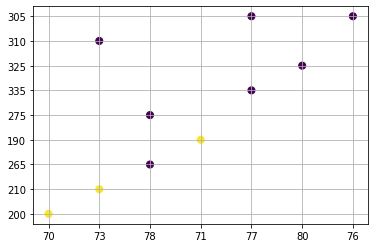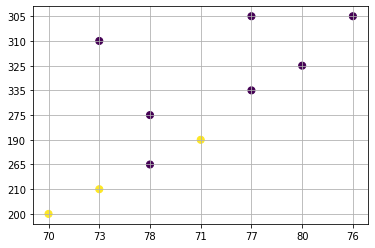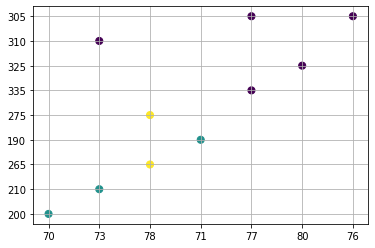Unsupervised Learning
- Given a set of feature vectors (without labels)
- Group them into natural clusters or create labels for groups
Here are some data on the New England Patriots and let us see how we can use clustering to create groups.
Features:
Name, height, weight
Labeled by type of position
Receivers: (label)
edelman = ['edelman’, 70, 200] <---- Feature vector
hogan = ['hogan', 73, 210]
gronkowski = ['gronkowski', 78, 265]
amendola = ['amendola’, 71, 190]
bennett = ['bennett’, 78, 275]
Linemen: (label)
cannon = ['cannon’, 77, 335]
solder = ['solder', 80, 325]
mason = ['mason’, 73, 310]
thuney = ['thuney', 77, 305]
karras = ['karras', 76, 305]
# r: receiver, l: linemen
ne_fb_players = [["edelman", 70, 200, "r"],
["hogan", 73, 210, "r"],
["gronkowski", 78, 265, "r"],
["amendola", 71, 190, "r"],
["bennett", 78, 275, "r"],
["cannon", 77, 335, "l"],
["solder", 80, 325, "l"],
["mason", 73, 310, "l"],
["thuney", 77, 305, "l"],
["karras", 76, 305, "l"]
]
import numpy as np
import matplotlib.pyplot as plt
nep_dataset = np.array(ne_fb_players)
plt.scatter( nep_dataset[:, 1], nep_dataset[:, 2])
plt.xlabel("Height")
plt.ylabel("Weight")
plt.grid()
plt.show()

X = nep_dataset[:, 1:3]
print (X)
kmeans = KMeans(n_clusters=2, random_state=0).fit(X)
kmeans.labels_
[['70' '200']
['73' '210']
['78' '265']
['71' '190']
['78' '275']
['77' '335']
['80' '325']
['73' '310']
['77' '305']
['76' '305']]
array([1, 1, 0, 1, 0, 0, 0, 0, 0, 0], dtype=int32)
As we the first 2 items and 4th item are in one cluster while all others in the second cluster
plt.scatter(X[:, 0], X[:, 1], c=y_kmeans, s=50, cmap='viridis')
# colormap viridis: https://matplotlib.org/stable/tutorials/colors/colormaps.html
plt.grid()
plt.show()

If we want to group them into 3 clusters, we need to provide n_clusters=3 as shown below:
kmeans = KMeans(n_clusters=3, random_state=0).fit(X)
